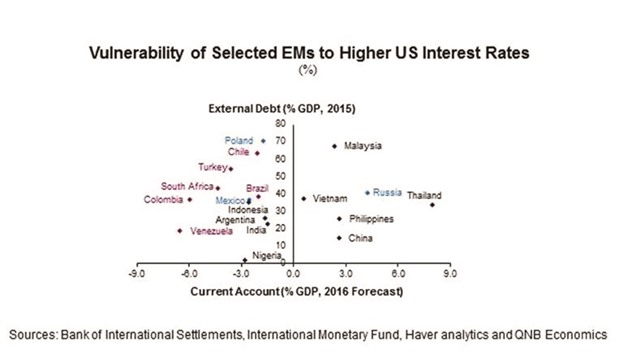Over the past month, the US Federal Reserve (Fed) has been sending clear signals that an increase in US interest rates is likely to occur within the coming months. Global financial markets have been stirred by the new expectations set by the Fed but the impact has been most strongly felt in emerging markets (EMs), according to QNB report.
Broad-based declines have been experienced in major EM currencies against the dollar since the Fed began communicating the possibility of a rate hike in early May. EM equity markets have fallen, the MSCI EM index is tracking a 1.6% decline since May 3 when Fed vice chair Dudley first raised the spectre of a Fed hike, and capital outflows from EMs have picked up.
In light of these developments, we turn our attention this week to EM vulnerabilities to a Fed hike and address whether or not EMs are better placed to withstand the current tightening cycle as compared to 2012, just before the so-called 2013 taper tantrum.
We assess EM vulnerabilities based upon three metrics in a sample of 18 major EM countries. The first metric is the current account balance. Fed tightening causes capital outflows to the US in search of higher yields. Countries with large current account deficits are the most sensitive to this development because they rely on capital inflows to finance these deficits, QNB report said.
The second metric is the external debt position of EM countries. Several EMs have high debt holdings in US dollar. Fed tightening will spur an appreciation of the dollar and consequently increase the cost of repaying and servicing this debt, creating a drag on growth. This could also increase investor risk aversion and further accelerate capital outflows.
The third metric is the growth outlook. A stronger growth outlook signals higher future returns for investors and attracts capital inflows. In contrast, a weaker growth outlook could also accelerate capital outflows and increase risk aversion.
Based on these metrics, we consider Brazil, Chile, Colombia, South Africa, Turkey, and Venezuela to be the most vulnerable EM countries to a Fed rate increase. All of these countries face current account deficits of 2% or more, growth rates below 4% and, with the exception of Venezuela, external debt levels of 30% or more of GDP.
Additionally, a number of country specific factors such as lower commodity prices and political instability are also affecting the growth outlook for some these countries. Following these countries, we judge that Poland, Mexico and Russia are at-risk countries. Poland and Mexico face current account deficits and higher external debt positions while Russia has weak growth outlook stemming from the fallout from lower commodity prices.
An interesting observation to note is that India is no longer a vulnerable or at-risk EM despite being widely classified as one in 2013, after the Fed ended its QE programme.
Since then, monetary policy easing and a sharp depreciation of the currency has supported a current account adjustment which, along with an improved fiscal balance, have upgraded India’s growth outlook.
What does this mean for EMs as a whole and are they better off than before? This Fed tightening cycle comes at a time when risks are elevated and commodity prices are weak.
The aggregate current account balance for EMs is estimated to be -0.6% of GDP and real GDP growth is forecast to be 4.1% in 2016 for emerging markets as a whole, according to the IMF.
This compares to a current surplus of 1.3% and real GDP growth of 5.2% in 2012, just before the onset of the taper tantrum. What is more, external debt of large EMs, excluding China, has increased from 23% of total GDP in 2012 to over 30% of GDP in 2015. Hence, we believe that EMs, in aggregate, are in fact more vulnerable than they were prior to the start of the taper tantrum.
In summary, a Fed rate hike seems likely in the coming months. The increase in US interest rates has the potential to generate financial volatility and could trigger a recurrence of capital flight from EMs given that they are worse off than they were in 2012, the QNB report said.

FED


